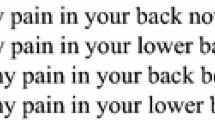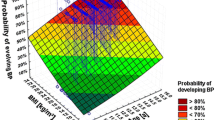Abstract
A cross-sectional study that targeted a total of 43,630 pupils in Niigata City, Japan was performed. The objective of the study was to evaluate the association between sports activities and low back pain (LBP) in childhood and adolescence in Japan. Regarding risk factors of LBP, a large number of studies have been conducted that have examined gender differences, height and weight, body mass index, sports time, differences in lifestyle, family history, and mental factors; however, no definitive conclusion has yet been made. A questionnaire survey was conducted using 43,630 pupils, including all elementary school pupils from the fourth to sixth grade (21,893 pupils) and all junior high pupils from the first to third year (21,737 pupils) in Niigata City (population of 785,067). 26,766 pupils who were determined to have valid responses (valid response rate 61.3%) were analyzed. Among the 26,766 pupils with valid responses, 2,591 (9.7%) had LBP at the time of the survey, and 8,588 (32.1%) had a history of LBP. The pupils were divided between those who did not participate in sports activities except the physical education in school (No sports group: 5,486, 20.5%) and those who participated in sports activities (Sports group: 21,280, 79.5%), and the difference in lifetime prevalence between No sports group and Sports group was examined. The odds ratio for LBP according to sports activity was calculated by multiple logistic regression analysis adjusted for gender, age, and body mass index. In addition, the severity of LBP was divided into three levels (Level 1: no limitation in any activity, Level 2: necessary to refrain from participating in sports and physical activities, and Level 3: necessary to be absent from school), and Levels 2 and 3 were defined as severe LBP; the severity was compared between No sports group and Sports group and in each sport’s items. Moreover, in Sports group, the amount of time spent participating in sports activities were divided into three groups (Group 1: less than 6 h per week, Group 2: 6–12 h per week, and Group 3: 12.1 h per week or more), and the dose–response between the amount of time spent participating in sports activities and the occurrence of LBP were compared. In No sports group, 21.3% experienced a history of LBP; in Sports group, 34.9% experienced LBP (P < 0.001). In comparison to No sports group, the odds ratio was significantly higher for Sports group (1.57), and also significantly higher for most of the sports items. The severity of LBP was significantly higher in Sports group (20.1 vs. 3.2%, P < 0.001). The amount of time spent participating in sports activities averaged 9.8 h per week, and a history of LBP significantly increased in the group which spent a longer time participating in sports activities (odds ratio 1.43 in Group 3). These findings suggest that sports activity is possible risk factors for the occurrence of LBP, and it might increase the risk for LBP in childhood and adolescence.



Similar content being viewed by others
References
Anderson LB, Wedderkopp N, Leboeuf-Yde C (2006) Association between back pain and physical fitness in adolescents. Spine 31:1740–1744
Balagué F, Dutoit G, Waldburger M (1988) Low back pain in schoolchildren. An epidemiological study. Scand J Rehabil Med 20:175–179
Balagué F, Nordin M, Skovron ML, Dutoit G, Yee A, Waldburger M (1994) Non-specific low-back pain among schoolchildren: a field survey with analysis of some associated factors. J Spinal Disord 7:374–379
Balagué F, Skovron ML, Nordin M, Dutoti G, Pol LR, Waldburger M (1995) Low back pain in schoolchildren—a study of familial and psychological factors. Spine 20:1265–1270
Balagué F, Troussier B, Salminen JJ (1999) Non-specific low back pain in children and adolescents: risk factors. Eur Spine J 8:429–438
Burton AK, Clarke RD, McClune TD, Tillotson KM (1996) The natural history of low back pain in adolescents. Spine 21:2323–2328
Cardon G, Balagué F (2004) Low back pain prevention’s effects in schoolchildren. What is the evidence? Eur Spine J 13:663–679
Harreby M, Neergaard K, Hesselsøe G, Kjer J (1995) Are radiologic changes in the thoracic and lumbar spine of adolescents risk factors for low back pain in adults? Spine 20:2298–2302
Harreby M, Nygaard B, Jessen T, Larsen E, Storr-Paulsen A, Lindahl A, Fisker I, Laegaard E (1999) Risk factors for low back pain in a cohort of 1389 Danish school children: an epidemiologic study. Eur Spine J 8:444–450
Hestbaek L, Leboeuf-Yde C, Kyvik KO, Manniche CM (2006) The Course of low back pain from adolescence to adulthood. Eight-year follow-up of 9600 twins. Spine 31:468–472
Jones GT, Macfarlane GJ (2005) Epidemiology of low back pain in children and adolescents. Arch Dis Child 90:312–316
Jones MA, Stratton G, Reilly T, Unnithan VB (2004) A school-based survey of recurrent non-specific low-back pain prevalence and consequences in children. Health Educ Res 19:284–289
Kelsey JK, White AA (1985) Epidemiology and impact of low back pain. Spine 5:133–142
Leboeuf-Yde C, Kyvik KO (1998) At what age dose low back pain become a common problem? A study of 29,424 individuals aged 12–41 years. Spine 23:228–234
Limon S, Valinsky LJ, Ben-Shalom Y (2004) Children at risk. Risk factors for low back pain in the elementary school environment. Spine 29:697–702
Poussa MS, Heliövaara MM, Seitsamo JT, Könönen MH, Huemerinta KA, Nissinen MJ (2005) Anthropometric measurements and growth as predictors of low-back pain: a cohort study of children followed up from the age of 11 to 22 years. Eur Spine J 14:595–598
Salminen JJ, Pentti J, Terho P (1992) Low back pain and disability in 14-year-old schoolchildren. Acta Paediatr 81:1035–1039
Salminen JJ, Erkintalo M, Laine M, Pentti J (1995) Low back pain in the young. A prospective three-year follow-up study of subjects with and without low back pain. Spine 20:2101–2108
Sato T, Ito T, Hirano T, Morita O, Kikuchi R, Endo N, Tanabe N (2008) Low back pain in childhood and adolescence: a cross-sectional study in Niigata City. Eur Spine J 17:1441–1447
Skoffer B, Foldspang A (2008) Physical activity and low-back pain in schoolchildren. Eur Spine J 17:373–379
Szpalski M, Gunzburg R, Balagué F, Nordin M, Mélot C (2002) A 2-year prospective longitudinal study on low back pain in primary school children. Eur Spine J 11:459–464
Taimela S, Kujala UM, Salminen JJ, Viljanen T (1997) The prevalence of low back pain among children and adolescents. A nationwide, cohort-based questionnaire survey in Finland. Spine 22:1132–1136
Tertti MO, Salminen JJ, Paajanen HE, Terho PH, Kormano MJ (1991) Low-back pain and disk degeneration in children: a case-control MR imaging study. Radiology 180:503–507
Watson KD, Papageorgiou AC, Jones GT, Taylor S, Symmons DPM, Silman AJ, Macfarlane GJ (2002) Low back pain in schoolchildren: occurrence and characteristics. Pain 97:87–92
Watson KD, Papageorgiou AC, Jones GT, Taylor S, Symmons DPM, Silman AJ, Macfarlane GJ (2003) Low back pain in schoolchildren: the role of mechanical and psychosocial factors. Arch Dis Child 88:12–17
Wedderkopp N, Leboeuf-Yde C, Andersen LB, Karsten F (2003) Back pain in children: no association with objectively measured level of physical activity. Spine 28:2019–2024
Widhe T (2001) Spine: posture, mobility and pain. A longitudinal study from childhood to adolescence. Eur Spine J 10:118–123
Acknowledgments
We would like to sincerely thank the members of the Niigata City board of education and others associated with the elementary schools and junior high schools in Niigata City for their valuable cooperation in making this study.
Author information
Authors and Affiliations
Corresponding author
Rights and permissions
About this article
Cite this article
Sato, T., Ito, T., Hirano, T. et al. Low back pain in childhood and adolescence: assessment of sports activities. Eur Spine J 20, 94–99 (2011). https://doi.org/10.1007/s00586-010-1485-8
Received:
Revised:
Accepted:
Published:
Issue Date:
DOI: https://doi.org/10.1007/s00586-010-1485-8




